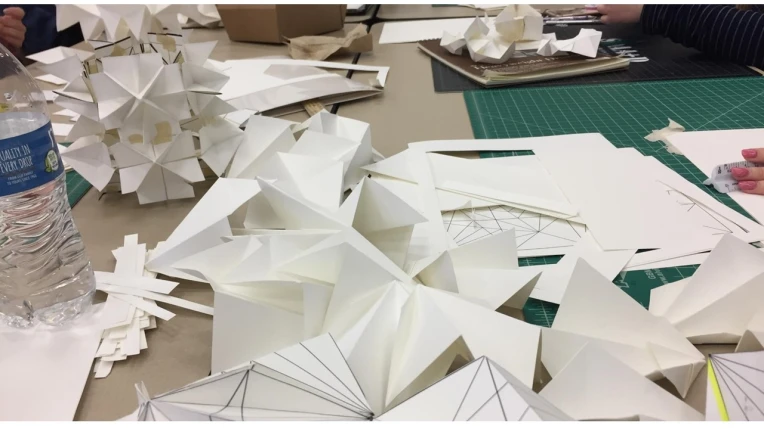
Citation: Wu, J. (2108). From Paper Folding to Digital Modeling in Beginning Interior Architecture Studio, IDEC Exchange: A Forum for Interior Design Education, Winter 2018.
Paper folding is easy to do by hand and does not require sophisticated tools. The form generation in paper folding is a direct result of material manipulation through a series of actions by hand. While paper folding can be easily done by hand, describing paper folding scientifically and representing the morphology that happens when a flat sheet of paper is folded, however, requires complex mathematical and computational modeling. Current CAD technologies, such as 3D modeling tools such as Rhino and Revit, are inadequate for such a tactile design process. In courses such as Beginning Interior Architecture studios, it is extremely difficult for the beginning design students to generate innovative forms directly using 3D modeling tools, which they are just beginning to learn. However, when they are asked to work with pieces of paper using their hands in free experiments, they learn to discover new ideas and find new forms, which then inspire them to generate digital alternatives that can be used in various scales in their interior design activities.






In an introductory interior design and architecture studio, paper folding was introduced to the first year students to help them understand basic design principles such as symmetry, repetition, and modality. The goal was to produce a small-scale paper folded light sculpture that is volumetric and that can enclose a light source. The project was divided into three small parts that serve as learning scaffolds. In the first part, the students were asked to create small units of paper folds from pieces of small square paper. Students were asked to draw simple line drawings based on two-dimensional compositions they made in a previous project using straight edges and compasses. They then were asked to give mountain and valleys assignments to the line drawings and they started folding. The students quickly found out that preconceived mountain and valley assignments often didn’t give rise to successful volumetric paper folds. Instead, they learned that folding paper was a very tactile experience and that each paper fold works like a small mechanism. To manipulate these small paper mechanics, one needed to cut, fold, pinch, pull, roll, tuck, and pop through a series of freehand experiments, similarly in ways to how a sculptor works with lumps of clay. While they started with some predesigned line drawings, they had to add new crease lines and ignore some original lines in their new paper folds. In the second part, the students were asked to connect four to eight units of their paper folds together. Students were taught to connect the units by using ways to make symmetries, such as translation, rotation, reflection, glide-reflection. They learned that to connect units together, they must pay attention to the boundary conditions of their paper folds. Complicate boundaries of a paper fold might be difficult to connect in modular form. In the third part, they were asked to use as many units as they needed to create their final design. They learned that by connecting these small paper mechanisms, they would end up with larger pieces of mechanisms which they need to manipulate again by hand to create the final stable volumetric forms. In addition, they were also taught to use polyhedral geometries, including icosahedron, dodecahedron, rhombic dodecahedron, etc., to connect the units into fixed three-dimensional volumes.
The beginning students often achieved great results in making a paper light and they were very proud of their work, which motivated them with later designs using digital tools. They were sometimes asked to produce digital alternatives of their paper structures. These digital alternatives were merely approximations of the paper fold structures. The digital models can then be used later in their other interior design projects either as small-scale light shades or as large-scale interior volumetric surfaces.